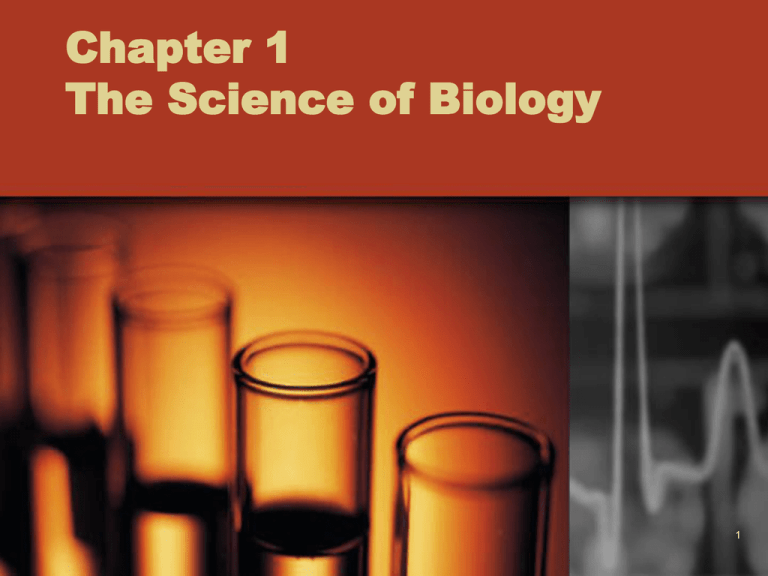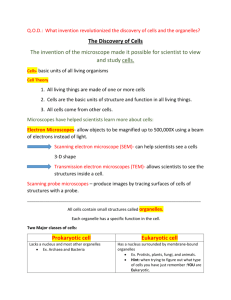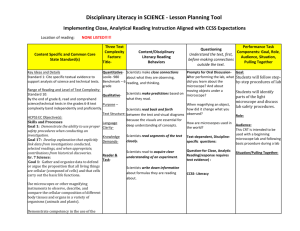
Chapter 1
The Science of Biology
1
1–1 What Is Science?
• Science is a process of inquiry,
asking questions, the answers to
which produce a body of knowledge,
which is subject to change and
revision.
• The goal of science is to investigate
and understand the natural world, to
explain events in the natural world
and to use those explanations to
make useful predictions.
2
• Science only deals with the natural
world. Biology is a field in science
that focuses on the study of life.
• An understanding of science and the
scientific approach is essential to
making intelligent decisions.
3
• Scientists collect and organize
information in a careful, orderly way,
looking for patterns and connections
between events.
• Scientists propose explanations that
can be tested by examining evidence.
Scientists try to explain events
logically and analytically.
4
• Scientific thinking begins with observation,
the process of gathering information about
events or processes in a careful, orderly
way.
• Observation generally involves using the
senses, particularly sight and hearing.
The information gathered from
observations is called data. Data consists
of observations that do not differ whether
collected by one person or another.
• Eg. Flame from a lighter/Candle Flame
5
• Two types of data:
– Quantitative data: expressed in numbers,
obtained by counting or measuring.
– Qualitative data: descriptive and involves
characteristics that can’t usually be counted.
6
• Scientists use data to make inferences, a
logical interpretation based on prior
knowledge or experience.
• After initial observations, a hypothesis is
proposed. A hypothesis is a proposed
scientific explanation for a set of
observations.
• Scientific hypotheses must be proposed in
a way that enables them to be tested.
7
• Science is an ongoing process, knowledge is
constantly being reevaluated, revised and
updated because of new tools, techniques and
discoveries.
• Good scientists are skeptics, questioning
existing ideas and new hypotheses.
• Common steps for scientists to gather
information and answer questions are known as
scientific methods. Not every scientific
investigation uses every method nor do all
investigations lead to scientific theory.
8
1-2 How Scientists Work
•
While there are no fixed steps, generally
the scientific method involves:
1) MAKE OBSERVATIONS: observations
utilize the senses to gather information.
Scientific discovery often takes place
when a scientist observes something no
one has noticed before.
9
2) ASK A QUESTION: observations
may lead to unanswered questions.
(Research may provide information
about previous investigations of the
question or suggest appropriate
approaches to the problem.)
3) FORM A HYPOTHESIS: an
explanation for a question or a
problem that can be formally tested.
A good hypothesis predicts a
relationship between cause and
effect.
10
4) SET UP A CONTROLLED
EXPERIMENT: While we use the term
experiment informally, a scientific
experiment is an investigation that tests
a hypothesis by the process of collecting
information under controlled conditions.
A controlled experiment involves two
groups:
11
a) Variable (Experimental) group: test group
that receives experimental treatment. A
variable is the factor of an experiment that can
change. In a controlled experiment, only one
variable is tested at a time. There are three
types of variables:
–
–
–
Controlled (constant) variables: same for both
the control and variable group.
Manipulated (independent) variable: variable that
is deliberately changed.
Responding (dependent) variable: changes in
response to the manipulated variable (what
happened).
12
b) Control group: group that receives no
experimental treatment, the standard
against which results are compared.
13
14
5) RECORD AND ANALYZE
RESULTS: keeping a written record
of observations and data. Data from
an investigation can be considered
confirmed only if repeating the
investigation several times yields
similar results.
6) DRAWING A CONCLUSION: Use
evidence to determine whether the
hypothesis was supported or refuted.
15
7) REPORTING RESULTS: Results
are only useful if they are made
available to other scientists for
peer review. Other scientists can
try to verify the results by repeating
the procedure.
16
17
• It is not always possible to do an
experiment to test a hypothesis.
– Alternative investigations may utilize fieldwork or
surveys or large groups of subjects, controlling as
many variables as possible.
• As evidence accumulates from scientific
investigations, a particular hypothesis may
become so well supported that scientists
consider it a theory. A theory is a well-tested
explanation that unifies a broad range of
observations.
– No theory is considered absolute truth. As new
evidence is uncovered, a theory may be revised
or replaced.
18
1 – 3 Studying Life
• The word biology means the study of
life. A biologist is someone who uses
scientific methods to study living
things.
• Describing what makes something
alive is not easy.
• No single characteristic is enough to
describe a living thing.
• Some non-living things share one or
more traits with living things.
19
Section 1-3
THE CHARACTERISTICS OF LIVING ORGANISMS
There are 7
characteristics:
•
•
•
•
•
•
•
Movement
Respiration
Sensitivity
Growth
Reproduction
Excretion
Nutrition
Movement
• An action by an organism or part of
an organism causing a change of
position or place.
Respiration
• The chemical reactions that break
down nutrient molecules in living
cells to release energy
Sensitivity
• The ability to detect or sense
changes in the environment (stimuli)
and to make responses.
Growth
• A permanent increase in size and
dry mass by an increase in cell
number or cell size or both.
Reproduction
• The processes that make more of the
same kind of organism
Excretion
• The removal from organisms of toxic
materials, the waste products of
metabolism (chemical reactions in
cells including respiration) and
substances in excess of
requirements.
Nutrition
• The taking in of
nutrients which are
organic substances
and mineral ions,
containing raw
materials or energy for
growth and tissue
repair, absorbing and
assimilating them.
Summary:
Write down the terms
•
•
•
•
•
•
•
Movement
Respiration
Sensitivity
Growth
Reproduction
Excretion
Nutrition
Quiz
Guess which characteristic is being
demonstrated by the following
animations:
Question 1
Question 2
Question 3
Question 4
Question 5
Which two characteristics are shown by
this animation:
Question 6
Other than movement, which characteristics
are shown by this animation:
Question 7
So far you should have
named a total of five
different characteristics.
However there are 7
characteristics in total.
Name the two
remaining
characteristics.
Answers:
How well did you do?
Question 1: Excretion
Question 2: Nutrition
Question 3: Movement
Question 4:
Reproduction
Question 5: Sensitivity and
Movement
Which two characteristics are shown by
this animation:
Question 6: Sensitivity and
Nutrition
Other than movement, which characteristics
are shown by this animation:
Question 7: Growth and
Respiration
So far you should have
named a total of five
different characteristics.
However there are 7
characteristics in total.
Name the two
remaining
characteristics.
Now you should be able
to
Define the characteristics of living organisms
1-4 Tools and
Procedures
Copyright Pearson Prentice Hall
A Common Measurement System
What measurement system do most
scientists use?
Copyright Pearson Prentice Hall
A Common Measurement System
Most scientists use the metric system when
collecting data and performing experiments.
Copyright Pearson Prentice Hall
A Common Measurement System
Because the metric system is based
on multiples of 10, it is easy to use.
Copyright Pearson Prentice Hall
A Common Measurement System
1 meter (m) = 100 centimeters (cm)
1 meter = 1000 millimeters (mm)
1000 meters = 1 kilometer (km)
1 kilogram (kg) = 1000 grams (g)
1 gram = 1000 milligrams (mg)
1000 kilograms = 1 metric ton (t)
1 liter (L) = 1000 milliliters (mL)
1 liter = 1000 cubic centimeters (cm3)
00C = freezing point of water
1000C = boiling point of water
Microscopes
How are light microscopes and
electron microscopes similar? How are
they different?
Copyright Pearson Prentice Hall
Microscopes
Microscopes
Microscopes are devices that produce
magnified images of structures that are too
small to see with the unaided eye.
Copyright Pearson Prentice Hall
Microscopes
Light Microscopes
The most commonly used microscope is the light
microscope.
Light microscopes produce clear images of objects at a
magnification of about 1000 times.
Copyright Pearson Prentice Hall
Microscopes
Compound light microscopes allow
light to pass through the specimen and
use two lenses to form an image.
Copyright Pearson Prentice Hall
Microscopes
Electron Microscopes
To study even smaller objects, scientists use electron
microscopes.
Copyright Pearson Prentice Hall
Laboratory Techniques
Laboratory Techniques
Cell Cultures
A single cell is able to reproduce so that a
group of cells, called a cell culture,
develops from the single original cell.
Copyright Pearson Prentice Hall
Laboratory Techniques
Cell Fractionation
Biologists often use a technique known as
cell fractionation to separate the different
cell parts.
Copyright Pearson Prentice Hall
Working Safely in Biology
Follow safe practices.
• Study the safety rules.
• Read all the steps and safety precautions.
• Follow your teacher’s instructions and textbook
directions exactly.
• If in doubt, ask your teacher for an explanation.
• Wash your hands thoroughly with soap and
warm water after every scientific activity.
Copyright Pearson Prentice Hall
1-4
A single measurement system is
commonly used in science because
• it allows scientists to easily replicate
one another’s experiments.
• basic units of mass, length, and
volume are unrelated to one another.
• more kinds of measurements can be
made.
• computers can store large amounts of
scientific data.
Copyright Pearson Prentice Hall
1-4
Compared to a light microscope, an
electron microscope is used to observe
•
•
•
•
larger objects with less detail.
larger objects with more detail.
smaller objects with more detail.
smaller objects with less detail.
Copyright Pearson Prentice Hall
1-4
A device that separates cell parts is a
•
•
•
•
centrifuge.
cell culture.
light microscope.
electron microscope.
Copyright Pearson Prentice Hall
1-4
A technique in which cells are grown in a
nutrient solution is known as
•
•
•
•
staining.
cell fractionation.
cell culturing.
cell fertilizing.
Copyright Pearson Prentice Hall
1-4
When you work in a biology
laboratory situation, your first
priority should be to
• make sure all materials are
available.
• modify any instructions that do not
make sense.
• familiarize yourself with all safety
rules before beginning to work.
• know ahead of time what kinds of
results to expect.
Copyright Pearson Prentice Hall
END OF SECTION









